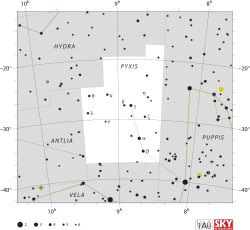Beta Pyxidis

| |
| Observation data Epoch J2000 Equinox J2000 | |
|---|---|
| Constellation | Pyxis |
| Right ascension | 08h 40m 06.14363s[1] |
| Declination | –35° 18′ 30.0″[1] |
| Apparent magnitude (V) | 3.954[2] |
| Characteristics | |
| Spectral type | G7Ib-II[3] |
| U−B color index | +0.646[2] |
| B−V color index | +0.935[2] |
| Astrometry | |
| Radial velocity (Rv) | –13.4[4] km/s |
| Proper motion (μ) | RA: +9.84[1] mas/yr Dec.: –20.80[1] mas/yr |
| Parallax (π) | 7.84 ± 0.19[1] mas |
| Distance | 420 ± 10 ly (128 ± 3 pc) |
| Absolute magnitude (MV) | –0.78[5] |
| Details | |
| Radius | 28[6] R☉ |
| Temperature | 5,400[7] K |
| Other designations | |
Beta Pyxidis (Beta Pyx, β Pyxidis, β Pyx) is a double star[3] located in the southern constellation Pyxis. It has an apparent visual magnitude of 3.954, making it the second brightest star in that faint constellation.
Based upon parallax measurements, the star is an estimated 420 light-years (128 parsecs) from the Earth.[1] The spectrum matches a bright giant or supergiant star of stellar classification G7Ib-II. The interferometer-measured angular diameter of this star is 2.05 ± 0.14 mas.[8] At its estimated distance, this yields a physical size of about 28 times the radius of the Sun.[6] The effective temperature of the star's outer envelope is about 5,400 K, giving it the characteristic yellow hue of a G-type star.[7][9]
In 2010, the star was among a survey of massive, lower effective temperature supergiants in an attempt to detect a magnetic field. This star may have a longitudinal magnetic field with a strength of less than a Gauss.[10] It is a young disk star system with space velocity components, [U, V, W] = [–11.0, +11.8, –2.2] km/s.[5] There is a magnitude 12.5 optical companion, located at an angular separation of 12.7 arcseconds and a position angle of 118° as of the year 1943.[11]
Naming
In Chinese, 天狗 (Tiān Gǒu), meaning Celestial Dog, refers to an asterism consisting of β Pyxidis, e Velorum, f Velorum, α Pyxidis, γ Pyxidis and δ Pyxidis. Consequently, β Pyxidis itself is known as 天狗四 (Tiān Gǒu sì, English: the Fourth Star of Celestial Dog.)[12]
References
- 1 2 3 4 5 6 van Leeuwen, F. (November 2007). "Validation of the new Hipparcos reduction". Astronomy and Astrophysics. 474 (2): 653–664. arXiv:0708.1752
 . Bibcode:2007A&A...474..653V. doi:10.1051/0004-6361:20078357.
. Bibcode:2007A&A...474..653V. doi:10.1051/0004-6361:20078357. - 1 2 3 Gutierrez-Moreno, Adelina; et al. (1966). "A System of photometric standards". 1. Publicaciones Universidad de Chile, Department de Astronomy: 1–17. Bibcode:1966PDAUC...1....1G.
- 1 2 3 "bet Pyx -- Star in double system". SIMBAD. Centre de Données astronomiques de Strasbourg. Retrieved 2009-04-15.
- ↑ Evans, D. S. (June 20–24, 1966). "The Revision of the General Catalogue of Radial Velocities". Proceedings from IAU Symposium no. 30, Determination of Radial Velocities and their Applications. University of Toronto: Dordrecht, D. Reidel Publishing Co. Bibcode:1967IAUS...30...57E.
- 1 2 Eggen, O. J. (1994). "Photometry of F-K type bright giants and supergiants. 3: The luminosity, reddening, and heavy element abundance of GK stars". The Astrophysical Journal. 107 (6): 2184–2210, 2205. Bibcode:1994AJ....107.2184E. doi:10.1086/117030.
- 1 2 Lang, Kenneth R. (2006), Astrophysical formulae, Astronomy and astrophysics library, 1 (3rd ed.), Birkhäuser, ISBN 3-540-29692-1. The radius (R*) is given by:
- 1 2 O'Neal, Douglas; Neff, James E.; Saar, Steven H. (November 1998), "Measurements of Starspot Parameters on Active Stars using Molecular Bands in Echelle Spectra", The Astrophysical Journal, 507 (2): 919–937, Bibcode:1998ApJ...507..919O, doi:10.1086/306340
- ↑ Richichi, A.; Percheron, I.; Khristoforova, M. (February 2005), "CHARM2: An updated Catalog of High Angular Resolution Measurements", Astronomy and Astrophysics, 431: 773–777, Bibcode:2005A&A...431..773R, doi:10.1051/0004-6361:20042039
- ↑ "The Colour of Stars", Australia Telescope, Outreach and Education, Commonwealth Scientific and Industrial Research Organisation, December 21, 2004, archived from the original on 2012-03-10, retrieved 2012-01-16
- ↑ Grunhut, J. H.; et al. (November 2010), "Systematic detection of magnetic fields in massive, late-type supergiants", Monthly Notices of the Royal Astronomical Society, 408 (4): 2290–2297, arXiv:1006.5891
 , Bibcode:2010MNRAS.408.2290G, doi:10.1111/j.1365-2966.2010.17275.x
, Bibcode:2010MNRAS.408.2290G, doi:10.1111/j.1365-2966.2010.17275.x - ↑ Worley, C. E.; Douglas, G. G. (November 1997), "The Washington double star catalogue (WDS, 1996.0)", Astronomy & Astrophysics Supplement Series, 125: 523, Bibcode:1997A&AS..125..523W, doi:10.1051/aas:1997239
- ↑ (Chinese) AEEA (Activities of Exhibition and Education in Astronomy) 天文教育資訊網 2006 年 7 月 17 日